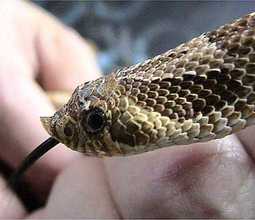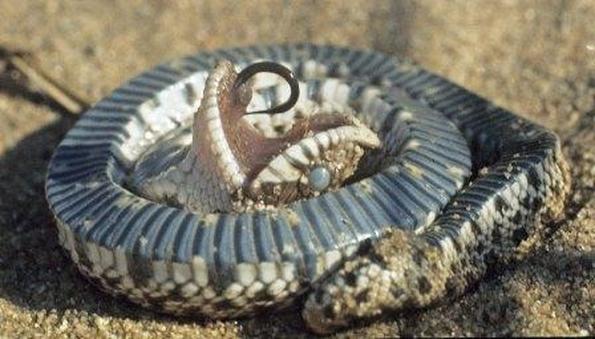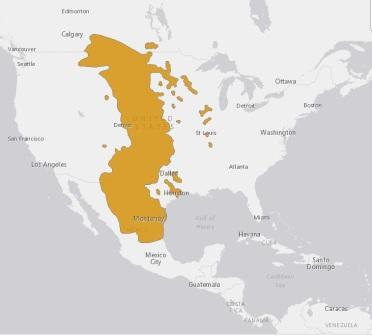Western hognose snakeHeterodon nasicus |

Custom Search
|
|
The western hognose snake (Heterodon nasicus) is of non-venomous colubrid snake species found in North America. Although there is some debate it's most often recorded as having 3 subspecies.
Their range extends from southern Canada to northern Mexico through the central United States. In Canada, it's found in southern Alberta, southern Saskatchewan, and southern Manitoba. In the US it's found mostly throughout the Great Plains regions, extending more or less disjunctly west to Colorado and Wyoming and east Minnesota, Missouri, Illinois, eastern Texas. Western hognose snakes are found in a variety of habitats with a loose sandy or gravelly soil, such as sandhills, prairies, river floodplains, open montane woodland, mesquite grassland, bajadas, thorn-scrub, semi-desert areas, creosote bush desert, wide valleys and occasionally mountain canyon bottoms. The western hognose also adapted to live in human modified areas including extensive agriculture and semi agricultural areas not intensively cultivated and in the margins of irrigation ditches. They are found at elevations ranging from near sea level to around 8,000 feet (2400 m). The Western hognose snake is a are relatively small but stout-bodied snake species with females being considerably larger than males. Adult specimens typically reach about 2 feet (60 cm) in length, with a maximum length of about 3 feet and weigh between 80 and 350 g. The color and pattern are highly variable between subspecies with dark oval markings extending down the center of their tan, brown, pale brown or yellowish back. With 2 additional rows of smaller, irregular and alternating dark blotches on either side. Their belly is heavily pigmented with black, particularly underneath the tail. The western hognose does have somewhat of resemblance to a rattlesnake, particularly a juvenile rattlesnake, and often is mistaken for one.So they are very often killed by people out of fear, thinking they are venomous and dangerous snakes.
Like other hognose snake species, they get their common name from their "hog-like" appearance due to a modified and strongly upturned rostral scale present in their snout. This particular adaptation also makes them snakes very good burrowers.
When they aren't active these snakes spend most of their time in existing or self-made burrows. Western hognose snakes are primarily diurnal. They brumate every year from September to March, only becoming active at the beginning of the mating season. Although they are considered a non-venomous snake, these snakes do possesses a potentially irritating saliva that in the extremely rare case of a bite may cause local itching and slight swelling. Although it's typically a docile snake if threatened or even perceiving a threat it will spread its jaws and flatten its neck giving it a hooded appearance in a cobra like fashion. If harassed it will hiss and make mock strikes with a closed mouth. If the attack continues, the western hognose puts on quite a dramatic show, twisting and turning its body rolling over onto its back and playing dead. In this feign death display they will open the mouth with their tongue hanging out. They may also throw up their last meal or even go as far as bleeding from the mouth. Virtually nothing will persuade them to move until the threat is gone, the snake's body will be limp and lifeless if picked up. After a few minutes if it perceives no threat, the snake quickly slithers away. This hissing behavior is the reason the western hognose snake is also known as the "puff adder" but these harmless, non-venomous snakes aren't even remotely related to the deadly puff adder (Bitis arietans) found in Africa. But these snakes are also known by many other common names such as Texas hognose snake, prairie hognose snake, bluffer, blow snake, spoonbill snake, spreadhead snake, Texas rooter, and faux viper. Some of the western hognose predators include fox, coyotes, hawks, crows, raccoons, larger snakes and both domestic cats and dogs. Their life expectancy in the wild is around 14 years. Subspecies / Taxonomy / Etymology
The subspecies sub-specific name, kennerlyi, was given in honor of Caleb Burwell Rowan Kennerly (1829-1861) an American naturalist. While the subspecies subspecific name, gloydi, is in honor of Howard K. Gloyd (1902-1978) an American herpetologist. Some scientists elevate H. n. kennerlyi to species level, and at the same time subsumed H. n. gloydi into H. nasicus considering only 2 valid species with no subspecies. But normally there are 3 recognized subspecies: Western hognose snake (H. n. nasicus - Baird & Girard, 1852) - Found from southeastern Saskatchewan and southwestern Manitoba in Canada south into the US through western Oklahoma and Kansas to New Mexico and Texas panhandle. It's also found some regions of Minnesota and Illinois. Gloyd's hognose snake (H. n. gloydi - Edgren, 1952) - Found in all of Texas excluding the panhandle, trans-pecos Texas and the extreme southern Rio Grande Valley, eastern Oklahoma, southeastern Missouri and southeastern Kansas. Kennerly's hognose snake (H. n. kennerlyi - Kennicott, 1860) - Found in the USA in southeastern Arizona, southwestern New Mexico, trans-pecos Texas and the extreme south of the Rio Grande Valley southward into Mexico. In Mexico is found along the Sierra Madre Occidental southeast into Tamaulipas and central San Luis Potosí. Diet / Feeding The Western hognose snake feeds on any animal that it can overpower and kill. Their diet includes predominantly amphibians such as frogs, toads, and reptiles like small lizards and other small snake species. But sometimes these snakes will eat rodents, small birds, and reptile or ground nesting birds eggs. Young snakes may even feed on insects. Like many other snakes they serve an important role in the environment, and are very effective in rodent control. They actively searches for prey, and will often use their characteristic upturned nose to dig holes in the ground while looking for burrowed toads in the sand. They aren't true constrictor snakes. They have to bite and chew driving the enlarged rear fangs into the prey as a way of introducing their toxic saliva and help subdue it. Reproduction The western hognose mating season occurs between June and August but they have been observed in copulating as early as the months of February and March. Females release a chemical which is picked up by males actively searching for receptive females. They are a polygamous species and both females and males will breed with multiple companions throughout the breeding season. They are also oviparous, meaning females lay eggs usually in the early summer. After copulation females will lay from 4 to 39 thin-shelled and elongated eggs burying them in the sand, a few inches below the surface. The eggs will hatch after an incubation period ranging from 52 to 64 days. Females do not provide any parental care for the eggs or the hatchlings. At birth, the western hognose hatchlings are fully developed and around 5 to 9 inches (13–23 cm) in total length.They reach sexual maturity at approximately 2 years of age, although the size is more important and not so much the snake's age. Conservation / Threats The western hognose is currently classified as Least Concern by the IUCN. Unlike their close relative the eastern hognose snake (Heterodon platirhinos) which is classified as threatened in some parts of its range and is therefore protected under state laws. Even though the western hognose snake as suffered some local declines it is still widespread today. Like other species, they are affected by the conversion of the original prairie habitat to agricultural land. They are protected by numerous conservation programs and have a large population size in excess of 100,000 specimens.
|
Did You Know?
In colder climates some snakes "hibernate" in the winter, this is called brumation, find more snake facts for kids. Scientific classification |
© 2014 Snake Facts About Us | Privacy Policy | Contact





